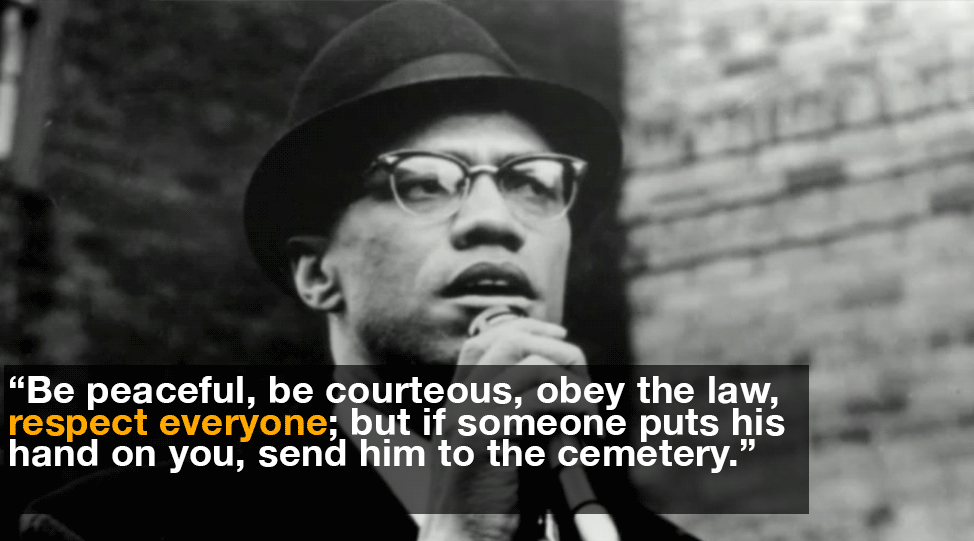Sun 12 January 2020:
A portrait of two different voices whose demands for black equality gave rise to gains in American civil rights.
A half-century after their deaths, Martin Luther King Jr and Malcolm X remain two of the world’s most revered political activists.
They were both respected leaders of the American Civil Rights movement, struggling for racial equality and freedom. But at the start of the 1960s, the media were constructing a conflict that stirred the civil rights debate: Malcolm X versus Reverend Martin Luther King.
Malcolm represented the kind of attitude and political perspective of many of young black so-called militants and radicals coming out of urban areas in the north. They had a different kind of attitude. It was hard for them to swallow this notion of non-violence … Malcolm says, ‘Somebody hits you. You send him to the cemetery’.
Herb Boyd, historian
While King advocated non-violent direct action and passive resistance to achieve equal civil rights, Malcolm X was the spokesman for the Nation of Islam (NOI), the black Muslim movement which violently rejected white America and its Christian values, and preached the supremacy of blacks over whites.
He promoted a segregationist approach that sought to instil in blacks a pride in their African heritage, whereas Martin Luther King believed that self-respect would come through integration.
“King was working to take down signs that prevented black people from riding buses where they wanted to, and to ride in trains, public transportation, preventing them from voting, and all of those things that black people were prevented from doing in the south. In the north, blacks always could vote, but as Malcolm said ‘You may have the vote but you ain’t no voting for nothing because they’ve already decided that you are not going to have any power’,” explains historian James H. Cone.
King once told the press that “the method of non-violent resistance is one of the most potent, if not the most potent weapons available to oppressed people and their struggle for freedom.”
However, for Malcolm, turning the other cheek was a weak strategy that was unacceptable.
“Malcolm comes from a black nationalist tradition that does not believe that you can get your freedom, your self-respect, your dignity by simply letting somebody beat up on you, and you do not try to defend yourself. That’s why Malcolm emphasised self-defence. But King emphasised non-violence because if blacks had responded, tried to defend themselves, that would have brought the police department down on those demonstrators and whites would have loved to have the chance to kill black people indiscriminately. So King and Malcolm had that tension,” says Cone.
Malcolm X regularly criticised King, accusing him of bowing to whites and subjugating blacks to the very culture that had historically denigrated and abused them.

“The white man pays Reverend Martin Luther King, subsidises Reverend Martin Luther King, so that Reverend Martin Luther King can continue to teach the negroes to be defenceless. That’s what you mean by non-violent: be defenceless. Be defenceless in the face of one of the most cruel beasts that has ever taken a people into captivity. That’s just the American white man,” Malcolm X said.
TV was young in the United States and King intuitively understood how to use the medium to highlight a non-violent black protest movement against white racist aggression.
In Washington, King continued his political work with a group of senators sympathetic to his ideas. He opened historic collaborations with the white community – joining the debate on the civil rights draft bill initiated by President John F Kennedy – that culminated in the March on Washington in 1963 and the signing of the Civil Rights Act in July 1964.
Malcolm X always wanted to meet King, but King never responded to Malcolm’s repeated requests for debate. After a hearing about the Civil Rights Act in Washington in 1964, they finally met face to face. Their meeting only lasted a minute, but the images that captured them side by side, both men smiling, became a strong symbol of reconciliation between two stridently different visions of the black cause.
“Those two people Martin and Malcolm, symbolised something that is in all African Americans. Each of us has a little bit of Martin and a little bit of Malcolm in us. Malcolm represents that blackness in us, that sense that we don’t want white people messing with us. Malcolm represents that fire, that fight that refuses to let anybody define who we are. King represents our desire to get along with everybody, including whites. Our desire to want to create a society for all people, defined by non-violence, love and care for all people in the society,” says Cone.
On February 21, 1965, Malcolm X was assassinated in New York, bringing an end to one of the most famous political debates in the history of black Americans.
 |
Martin Luther King gave his public reaction a few days later: “I think Malcolm X did serve a role, I think he played a role in pointing out the problem, calling attention to it, but his great problem was an inability to emerge with a solution. He had slogans that were catchy and that people listened to, but I don’t think he ever pointed out the solution to the problem.”
What King didn’t know was that in death, Malcolm X would become much more than a rival. He became a memory, a revolutionary consciousness for a generation of young blacks. Chanted in the ghettos, word of his death would resonate like a revenge on King.
On April 4, 1968, Martin Luther King was assassinated in Memphis. A few days later, at his funeral, the black community was not only mourning its national leader three years after the violent death of Malcolm X, it was laying to rest the two dreams that shaped the history of African Americans.
Source: Al Jazeera
Think your friends would be interested? Share this story!





